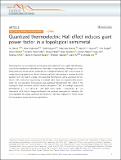Quantized thermoelectric Hall effect induces giant power factor in a topological semimetal
Author(s)
Han, Fei; Andrejevic, Nina; Nguyen, Thanh; Kozii, Vladyslav; Nguyen, Quynh T; Hogan, Tom; Ding, Zhiwei; Pablo-Pedro, Ricardo; Parjan, Shreya; Skinner, Brian; Alatas, Ahmet; Alp, Ercan; Chi, Songxue; Fernandez-Baca, Jaime; Huang, Shengxi; Fu, Liang; Li, Mingda; ... Show more Show less
DownloadPublished version (2.751Mb)
Publisher with Creative Commons License
Publisher with Creative Commons License
Creative Commons Attribution
Terms of use
Metadata
Show full item recordAbstract
© 2020, The Author(s). Thermoelectrics are promising by directly generating electricity from waste heat. However, (sub-)room-temperature thermoelectrics have been a long-standing challenge due to vanishing electronic entropy at low temperatures. Topological materials offer a new avenue for energy harvesting applications. Recent theories predicted that topological semimetals at the quantum limit can lead to a large, non-saturating thermopower and a quantized thermoelectric Hall conductivity approaching a universal value. Here, we experimentally demonstrate the non-saturating thermopower and quantized thermoelectric Hall effect in the topological Weyl semimetal (WSM) tantalum phosphide (TaP). An ultrahigh longitudinal thermopower Sxx~1.1×103μVK−1 and giant power factor ~525μWcm−1K−2 are observed at ~40 K, which is largely attributed to the quantized thermoelectric Hall effect. Our work highlights the unique quantized thermoelectric Hall effect realized in a WSM toward low-temperature energy harvesting applications.
Date issued
2020Department
Massachusetts Institute of Technology. Department of Nuclear Science and Engineering; Massachusetts Institute of Technology. Department of Materials Science and Engineering; Massachusetts Institute of Technology. Department of PhysicsJournal
Nature Communications
Publisher
Springer Science and Business Media LLC